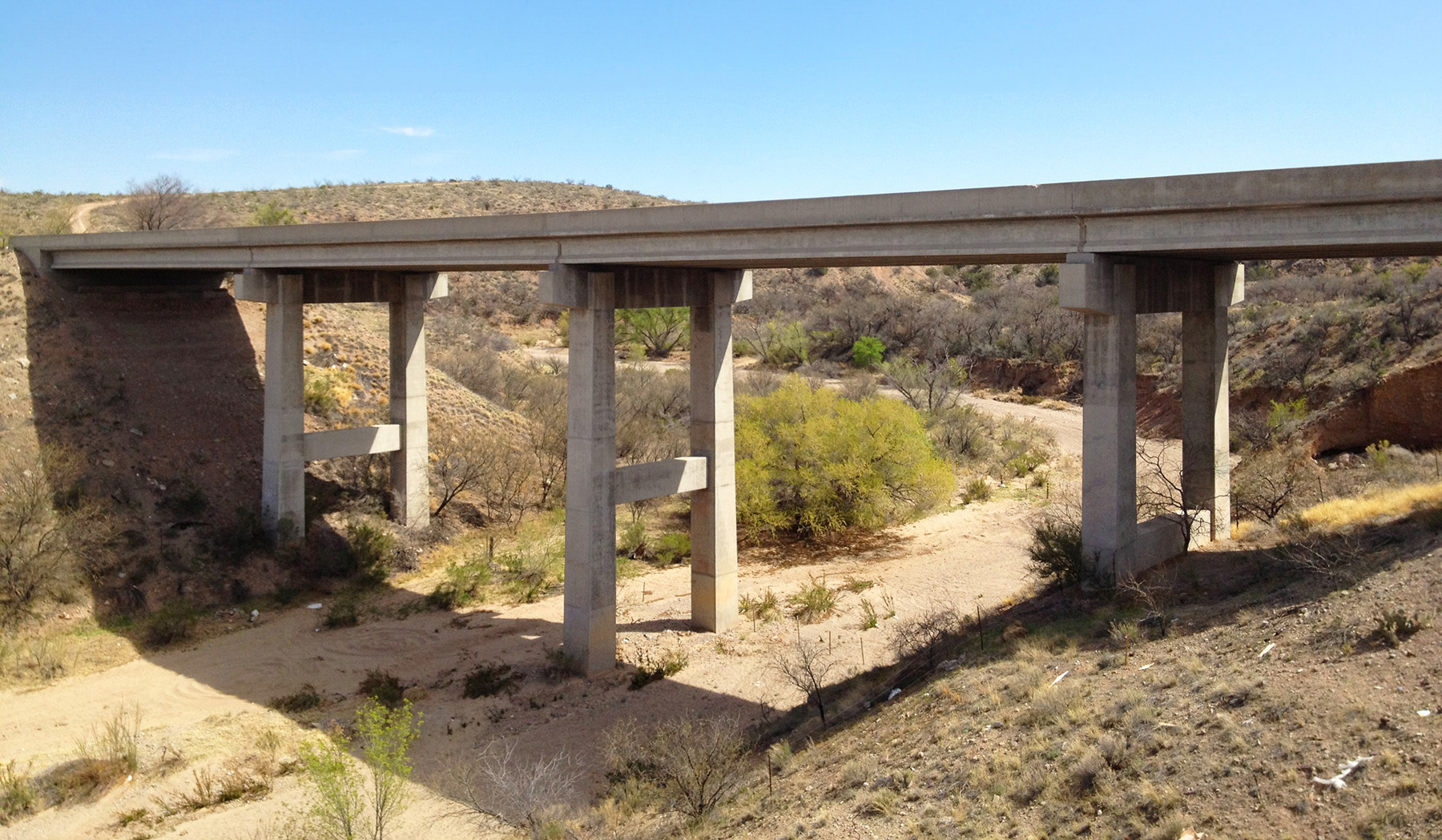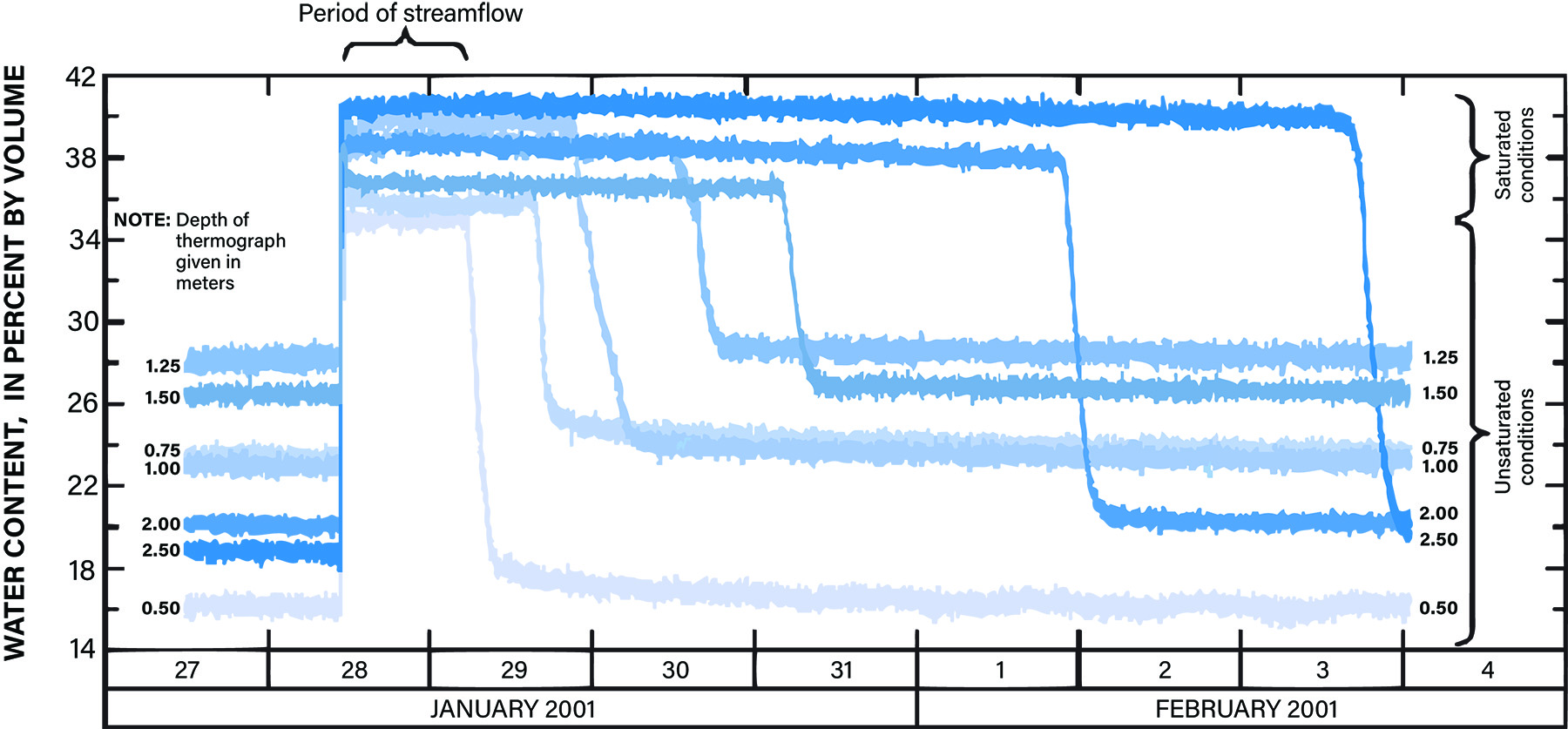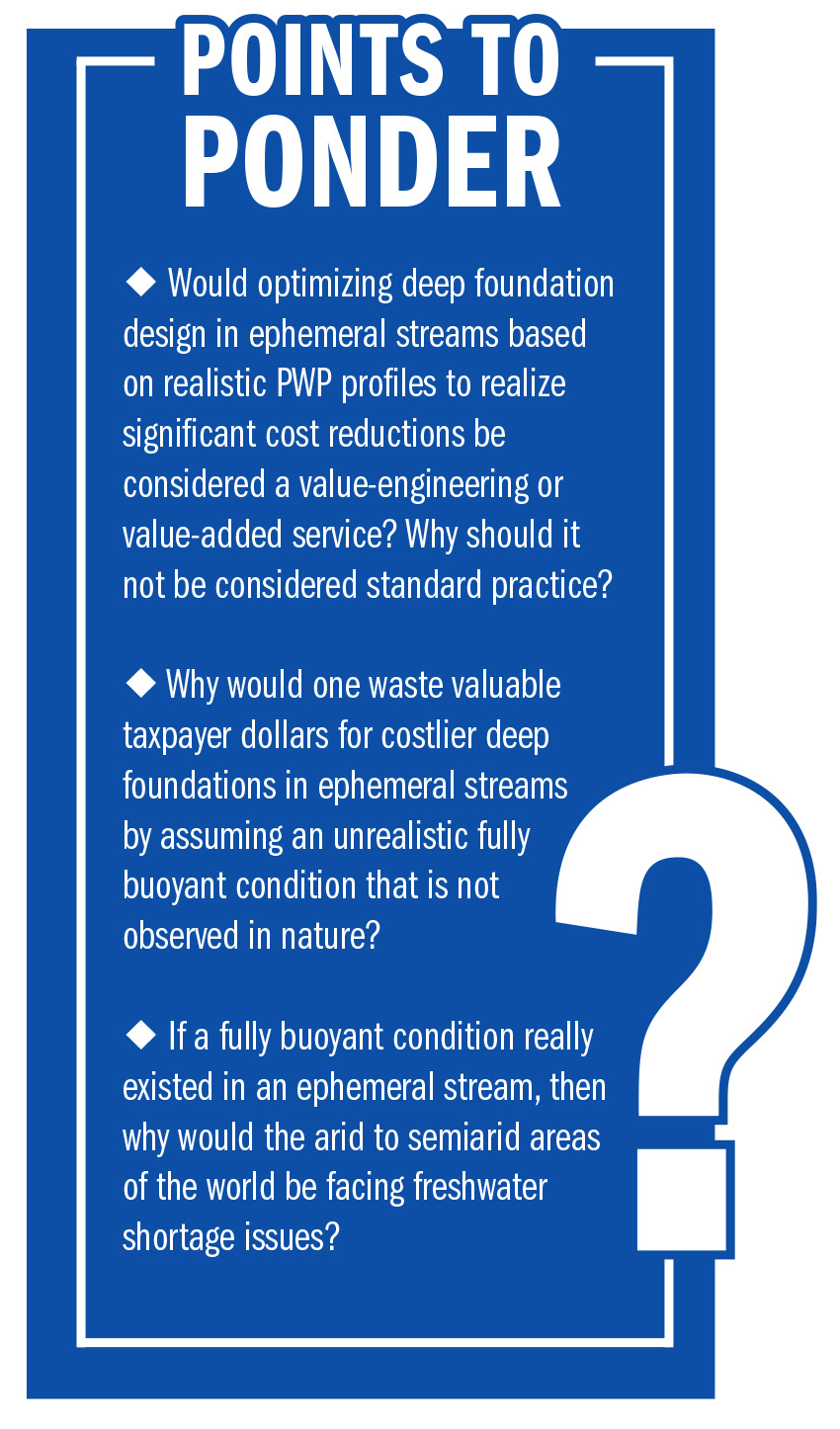
By Naresh C. Samtani, Ph.D., P.E., BC.GE, F.ASCE
Due to scour-related concerns, designers often prefer the use of deep foundations for bridge structures in stream environments. Figure 1 shows an example of a bridge crossing over perennial and ephemeral streams.
Because a perennial stream has flows throughout the year, the entire streambed is saturated and fully buoyant, wherein the positive pore water pressure, or PWP, for deep foundation analysis can be estimated from the linearly distributed hydrostatic water pressure shown in Figure 1a. In contrast, an ephemeral stream has flows only during a finite duration flood, which may be caused by rainfall, discharge from an upstream water retention facility, or both. In an ephemeral stream, the regional groundwater level could be at a considerable depth below the top of the streambed, and the hydrostatic water pressure occurs only below the GWL shown in Figure 1b.

In an ephemeral stream, a flood will cause a transient hydraulic pressure head at the scour level. Water will infiltrate into the streambed due to the difference in total head at the scour level and GWL. The infiltration rate is a function of factors such as flood height and duration, depth to the GWL, climate factors (e.g., evapotranspiration), and the subsurface hydrological properties of streambed soils, such as the soil-water characteristic curve and hydraulic conductivity.
For a given soil, the soil-water characteristic curve defines the constitutive relationship between water content and PWP over a range of PWP from fully buoyant to a large negative (suction) value such as 106 kN/m2. The hydraulic conductivity over the same range of PWP can be estimated by using saturated hydraulic conductivities and the properties of the soil-water characteristic curve.
A positive hydrostatic PWP profile will be observed during a flood for a short depth immediately below the scour level. Below this depth, the remainder of the streambed to the GWL will experience mainly unsaturated (i.e., partially saturated) conditions wherein the PWPs will have nonlinear profiles with magnitudes that are less than those at the fully buoyant condition but greater than zero, negative, or a combination of both. The patterns and magnitudes of these nonlinearly distributed PWPs can vary widely, and such variations need to be understood for optimizing deep foundation designs in ephemeral streams.
Infiltration phenomena
The United States Geological Survey has extensively studied infiltration in ephemeral streams as part of groundwater recharge programs. For example, to study infiltration fluxes during streamflow in Rillito Creek, an ephemeral stream in Tucson, Arizona, the USGS installed a 2D vertical array of 28 paired thermocouples, temperature probes, and time-domain reflectometry water content probes. The results were documented in terms of in situ water content as shown below.

The key observations based on Figure 2 are that there is a rapid increase in water content immediately after the onset of streamflow, and the water content decreases to pre-streamflow values shortly after the streamflow has ceased. The water content can increase to levels where localized saturation of the streambed can occur, and a fully buoyant condition can develop within such localized saturated zones. However, the fully buoyant condition is transient and of short duration because the water content values rapidly decrease, leading to unsaturated conditions during which nonlinear negative PWPs develop. These processes result in a wide range of PWP profiles with depth across the streambed.
The water content patterns in Figure 2 are not a recent discovery. Indeed, such patterns are well known and were identified more than a century ago by agronomists and soil physicists. Several mathematical models are available that can simulate infiltration and predict water content patterns (see https://www.epa.gov/water-research/infiltration-models). Several software programs based on finite element numerical procedures are also available for infiltration analyses.
Geotechnical resistance
Coarse-grained soils are typical in ephemeral streams. Side resistance of a deep foundation in coarse-grained soils is often expressed as a direct function of effective stress (total geostatic stress – PWP). Depending on the methods chosen for deep foundation analysis, similar considerations can also apply for tip (bottom or base) and lateral resistances. Thus, to estimate these geotechnical resistances, a PWP profile with depth is needed to compute the corresponding effective stress profile. These PWP profiles must be based on a site- and project-specific infiltration analysis.
Flood events and PWP profiles
Flood events in ephemeral streams can be quite variable. Figure 3 shows example flood hydrographs in an ephemeral stream. The transient hydraulic head for infiltration analysis is applied in accordance with a flood hydrograph at the applicable scour level. If the rate of application of hydraulic head exceeds the hydraulic conductivity, only a limited amount of floodwater will infiltrate the streambed, and the balance of the flood will advance downstream. This usually occurs during the initial portion of a flood when a rapid increase in flood height occurs.

The infiltration fluxes will vary throughout and after the flood event. Thus, the PWP profiles during a flood event will vary widely within the streambed above the GWL.

Figure 4 shows schematic PWP profiles during and after a flood that can occur in a streambed with uniform hydrological properties. Various features shown in Figure 4 are as follows:
1. Profile A-B represents the hydrostatic distribution below the GWL and a fully buoyant condition.
2. Profile A-C represents a negative PWP distribution that is considered to be the extension of hydrostatic Profile A-B. This profile is used as an initial condition in numerical analysis.
3. Profile D-E-E1-F-G represents a hydrostatic (fully buoyant) distribution. The D-E portion of this profile is within the height of the transient flood. The location of this line will change based on flood height.
4. The slope of profiles C-A-B and D-E-E1-F-G is the same, as both are based on a hydrostatic distribution.
5. Profile D-E-E1-A-B indicates the upper portion of the streambed at and immediately below the scour level up to Point E1 will experience a fully buoyant condition. Below Point E1, the PWP will reduce to zero at Point A and the profile will merge into Profile A-B. This profile typically occurs when the flood has reached peak height, and it represents the maximum positive PWP experienced within the streambed. A variation of this profile can occur when a negative PWP develops for a limited distance above the GWL to Point E2. Such a variation can occur when the water storage capacity of the streambed above the GWL is larger than the flood volume. These PWP profiles are representative of partially buoyant conditions.
6. Profile E3-E4-A-B occurs toward the end of a flood. At this time negative PWP develops as indicated by the portion of this profile to the left of Point E4.
7. Profile E5-E6-A-B develops after cessation of the flood and as the PWP recedes to the pre-flood negative values above the GWL.
8. Profile E7-E8-E6-A-B can develop where near-surface drying occurs due to evapotranspiration.
9. Profile S-E4-E2-A-B represents zero PWP above the GWL. This profile is referenced herein as a non-buoyant condition.
The location of points E1 to E8 vary during and after the flood event. Furthermore, the hydrological properties are rarely uniform in a stream depositional environment, and therefore, the PWP profiles can have different shapes between the profiles shown in Figure 4. The presence of clay or cemented soils that can perch water or fine-grained soils that can retard flows lead to complex PWP conditions.

The engineering properties of soils for infiltration analysis should be estimated from appropriate laboratory tests (particularly for the soil-water characteristic curve and hydraulic conductivity properties) on representative undisturbed samples over the full range of possible positive and negative PWPs.
These properties — along with the stream geometry and subsurface stratigraphy based on hydrological properties — are used to construct the numerical model for evaluation of infiltration fluxes and PWP profiles.
It is not appropriate to estimate PWP profiles based on borehole infiltration tests or vibrating wire piezometer types of instrumentation because they do not consider factors such as the full range of PWPs, flood variations projected over the design life of foundations, hysteresis due to drying and wetting, lateral spread of infiltration, and geometry of the stream and stream banks — all of which separately or in combination can have considerable influence on the PWP profiles.
The hydrogeologic setting of every ephemeral stream is unique. Evaluation of PWPs during flood events should be performed by qualified specialists on a site- and project-specific basis.
The paper “Infiltration Study for Deep Foundations in Ephemeral Streams,” by the author of this article, presents a detailed case history that includes information on development of appropriate properties for infiltration analysis, features of numerical models, and how to interpret the results and PWP profiles.
Design approaches
Due to the lack of formal guidance or continuation of past practices, designers generally assume either a fully buoyant condition (Profile D-E-E1-F-G) or a non-buoyant condition (Profile S-E4-E2-A-B). The implications of the two approaches on deep foundation designs are as follows:
1. The total unit weight of coarse-grained soils that typically occurs in ephemeral streams ranges from 17 to 21 kN/m3. Given that the unit weight of water is 9.8 kN/m3, the effective stresses can be about 40-55% of the total geostatic stresses for the fully buoyant condition. Thus, the geotechnical resistances will be similarly less, and use of the fully buoyant condition will lead to the largest deep foundation sizes and costs.
2. Because the non-buoyant condition assumes zero PWP in the streambed above the GWL, the geotechnical resistances are maximized, leading to the smallest deep foundation sizes and costs. However, such deep foundation sizes may be scour critical and, therefore, not desirable.
Neither of these approaches represents actual conditions. Deep foundation designs should be based on the more realistic Profile D-E-E1-A-B, which represents the maximum positive PWP that can be experienced during a flood. The difference in the positive PWPs below Point E1 between Profile D-E-E1-A-B and the fully buoyant profile can be considerable, particularly in cases of deep GWLs.
Using the more realistic Profile D-E-E1-A-B will result in larger effective stresses and geotechnical resistances, which help reduce deep foundation sizes compared with those based on the fully buoyant condition and thereby realize significant cost reductions. Comparisons of deep foundation costs based on fully buoyant and non-buoyant conditions are misleading because the costs associated with remedial measures due to scour-related damage will likely far outweigh any initial cost reductions.
The case history presented in “Infiltration Study for Deep Foundations in Ephemeral Streams” demonstrates the implementation of the realistic approach discussed herein and includes a detailed discussion of cost reductions. Since 2010 the author has implemented the infiltration approach for several bridges and has realized significant cost reductions to the tune of millions of dollars for the owners.
Implications for taxpayer dollars and the environment
Ephemeral streams occur in arid to semiarid regions. About a third of Earth’s land surface experiences arid or semiarid climates. Due to global warming, the areas where such climates occur are expected to expand. In the U.S., the arid to semiarid southwestern regions (e.g., Arizona, Nevada, and New Mexico and parts of California and Texas, etc.) are among the fastest growing with large infrastructure needs.
There are more than 615,000 bridges in the U.S., and thousands of these bridges and other structures with deep foundations are in arid to semiarid regions. Worldwide, there approach can help realize rational and economical deep foundation designs in ephemeral streams, leading to better use of taxpayer dollars along with environmental benefits such as a reduction in the carbon footprint and sustainable use of natural resources.
Acknowledgments
The author is deeply indebted to the late professor Edward A. Nowatzki, Ph.D., P.E., D.GE., F.ASCE, for his guidance and technical reviews during the development and early implementation phase. For this article, the author is thankful to James C. Scott, P.E., principal engineer, AECOM, and Richard J. Ellis, P.E., transportation services director, Pima Association of Governments, for their review comments.
Naresh C. Samtani, Ph.D., P.E., BC.GE, F.ASCE, is the president of NCS GeoResources LLC, in Tucson, Arizona. More information about Naresh can be found at www.ncsgeoresources.com and he can be reached at [email protected].
References
United States Geological Survey. (2007). “Estimated infiltration, percolation, and recharge rates at the Rillito Creek focused recharge investigation site, Pima County, Arizona.” https://pubs.usgs.gov/pp/pp1703/h/.
Samtani, N. C. (2020). “Infiltration study for deep foundations in ephemeral streams.” International Journal of Geoengineering Case Histories, Vol. 5, Issue 2, pages 118-137. https://dx.doi.org/10.4417/IJGCH-05-02-04.
This article first appeared in the January/February 2024 print issue of Civil Engineering as “Optimizing Deep Foundation Designs in Ephemeral Streams to Significantly Reduce Costs.”
Want to know more about this topic? Join Naresh for a free webinar on Wed. Jan. 24 at 11:30 a.m. ET.



